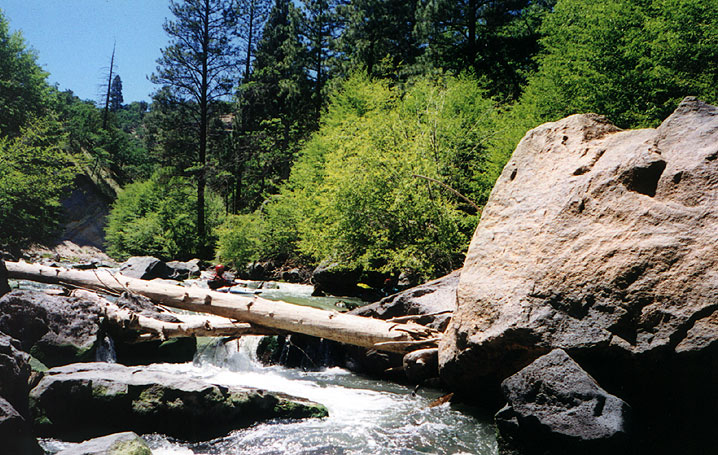Copyright 2001, Oregon Kayaking. No part of this page may be reproduced, linked, or copied without the express permission of the Oregon Kayaking Webmaster.
The White River gets its name from the glacial silt that clouds the river at it's source. Originating at the head of the glacier on Mt. Hood, this river usually runs late into the summer and is paddled regularly. Because the river is in eastern Oregon, the weather is almost always hot in the spring and summer, so dress accordingly. I ran this section with Mike Haley and Tom Powers, after running the Upper (Keeps Mills) section the day before. We all agreed that the lower was much mellower but also much more scenic than the upper section.
Tom Powers plays around as we enter the canyon on the lower.

The character of this section is more pool-drop than the upper (Keeps Mills run) section. The pools can be long at times, but the canyon is so striking you won't really care. That said, the boulders forming the rapids on this run are much larger than the upper section, and tend to gather wood as a result. You can run all of the drops by boat scouting, but I don't recommend it unless you have a healthy dose of log repellent on your boat that day. Besides, the scenic beauty of this canyon is the primary reason to paddle this stretch, so why hurry?
Mike and Tom somewhere on the Lower White.

Now a photo of one of the loggy rapids. As you can see, a little prudent eddy hopping is all that is required to safely navigate this drop. However, be careful in there. If you have read Steve Stuckmeyer's essay 'Aqualung' on this site you know that the penalty for complacency on this run can be very high.

Like I said, I did this trip with Mike and Tom, and a funny thing happened as the day wound down. We were drifting along, shooting the breeze, you know. The river was mellow here but fast, and we were all looking forward to dinner at the campsite. Mike was floating sideways downstream near the bank, looking back up at Tom and I and talking. I looked away for a second and I heard a loud 'thud' and when I looked back Mike's boat was upside down! Tom and I started laughing as we saw what had happened; Mike hadn't been keeping an eye out and had gotten smacked (hard!) in the back of the head by a large stick prodtruding from the bank, just at head level for him. To this day we tease him about this, so the next time you see him on the river be sure to join in the fun..
A note on flows: In the spring during snowmelt all of the water is coming down from above (or proportionally more) so the gauge readings will understate the actual or equivalent flow because they are so far downstream. This is especially true for the upper section of the white.
